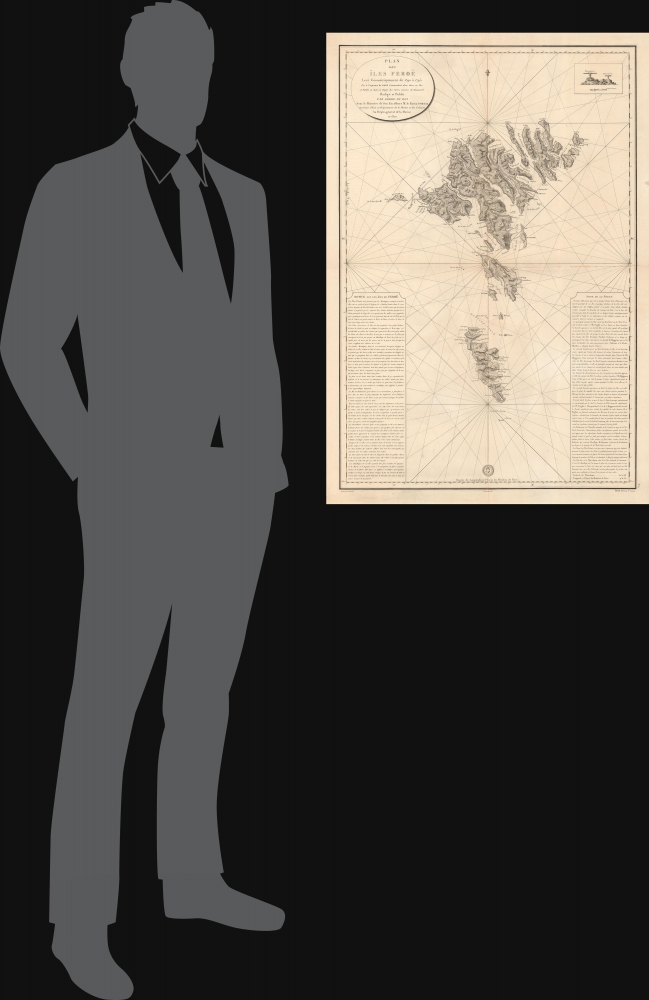1820 Dépôt de la Marine Nautical Map of the Faroe Islands
FeroeIsles-depotmarine-1820
Title
1820 (dated) 37 x 25.25 in (93.98 x 64.135 cm) 1 : 190000
Description
Born in the Faroes
While serving the Danish crown as an artillery officer, Christian Ludwig Ulrich von Born was commanded to complete a survey of the previously little known North Atlantic archipelago. This he completed over five years between 1790 and 1795. The Faroes had long proved difficult to survey due to long winters, short summers, and treacherous seas between the many islands. Born completed the survey with land-side triangulation and setting up equipment at high points along the shores. The original manuscript maps, which survive, consisted of seven maps on a uniform scale of 1:72000 and one general map at 1:290000. He was lavish in his depiction of inland landscape detail and even drew stunning cartouches illustrating Faroese life. For unknown reasons, the Danish maritime mapping agency did not publish his charts until 1806. Although examples of the 1806 Danish chart survive, it has no history on the market. This 1820 map issued by the French Dépôt des Cartes et Plans de la Marine is a close copy of the 1806 map and is only known in two examples (including this one).Publication History and Census
This rare map was published by the French Dépôt des Cartes et Plans de la Marine in 1820. It is based upon an earlier chart published in 1806 by the Danish government after the hydrographic of Captain C. L. U. Born. It was engraved by Sébastien-François Bouclet with typography by J.P. Besançon. We note just one other surviving example, at the Bibliothèque Sainte-Geneviève at the Sorbonne in Paris, France.CartographerS
Christian Ludwig Ulrich von Born (1744 - 1805) was a Danish military and naval officer best known for his hydrographic work around the Faroe Islands. Born also served as magistrate of Apenrade, Denmark. More by this mapmaker...
Dépôt des Cartes et Plans de la Marine (fl. 1720 - present), often called the Dépôt de Marine, was a French hydrographic mapping organization founded in 1720 under Charles-Hercule of Albert de Luynes (1674 - 1734). Much like the U.S. Coast Survey, the British Admiralty, and the Spanish Deposito Hydrografico, the Dépôt was initiated as a storehouse and distribution center of existing nautical and marine charts. Eventually the Dépôt initiated its own mapping activities in an attempt to improve and expand upon existing material. Some of the more prominent cartographers and hydrographers associated with the of Dépôt des Cartes were, Philippe Buache, Jacques-Nicholas Bellin, Giovanni Rizzi-Zannoni, Rigobert Bonne, and Jean Nicolas Buache. Learn More...
Sébastien-François Bouclet (fl. c. 1800 - 1825) was a French engraver active in Paris in the late 18th and early 19th centuries. He engraved extensively for the Dépôt des Cartes et Plans de la Marine. Among those he taught is the Spanish engraver Felipe Cardano y Bauzá (1778 - 1824). Learn More...
J.P. Besançon (fl. c. 1798 - 1835) was a French engraver who specialized in lettering. Besançon began engraving nautical charts for Charles-François Beautemps-Beaupré (August 6, 1766 - March 16, 1854) in 1802. He engraved eighty-three maps for Beautemps-Beaupré, then the hydrographer in chief, between 1802 and 1831, when he handed off the work to J.M. Hacq. Little else is known about Besançon's life and career. Learn More...




